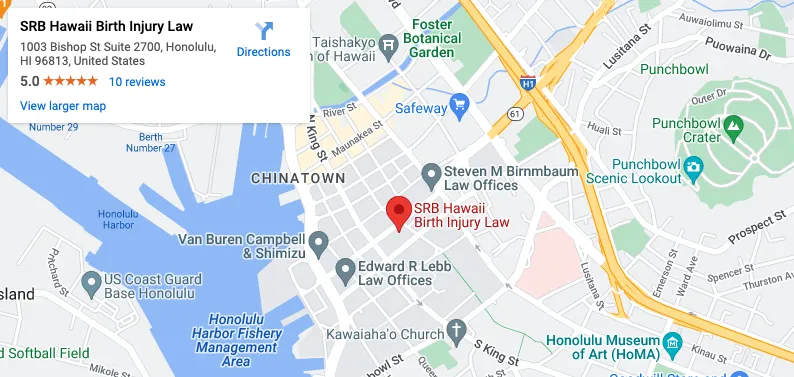SHOULDER DYSTOCIA AND BRACHIAL PLEXUS INJURIES LEGAL SERVICES in HonoLULU, Hawaii
Shoulder dystocia is an obstetric emergency. It is a complication that happens when a baby’s shoulder becomes stuck behind the mother’s pelvic bone during delivery. If this obstruction occurs, attending medical professionals must act quickly and appropriately to free the impacted shoulder and prevent serious birth injuries.
Some delivery interventions, including excessive pulling or twisting motions, place undue stress on the baby. This can result in numerous injuries, including damage to the brachial plexus, a network of nerves located in the shoulder, arm, and hand.
If you experienced the birth complication shoulder dystocia and your child sustained a permanent injury, you may be entitled to compensation. Contact experienced birth injury attorney Stephen Brzezinski today. SRB Hawaii Law serves clients on all of the Hawaiian Islands.
What are the birth injuries caused by shoulder dystocia?
Shoulder dystocia can lead to serious birth injuries such as:
- Oxygen deprivation/ birth asphyxia
- Hypoxic ischemic encephalopathy (HIE)
- Fractures and broken bones
- Brachial plexus palsy
Mothers can also experience medical complications if shoulder dystocia occurs. These complications include hemorrhaging, lacerations, and uterine rupture.
In many cases, injuries to the mother and child caused by shoulder dystocia heal relatively quickly. However, some injuries can have a lifelong impact or, at worst, prove fatal. For example, a baby who experiences nerve damage during delivery may face problems such as permanent paralysis.
What are Brachial Plexus Injuries?
Brachial plexus injuries often happen after shoulder dystocia, particularly when force is used to pull the baby from the birth canal. If one side of the baby’s body is stretched, the nerves may also be stretched. This can cause temporary or permanent damage.
In general, there are four types of injury that can affect the nerves:
- Neurapraxia: The most common type of nerve injury. It is a stress injury that does not tear the nerve and typically heals within three months.
- Neuroma: A stretch injury that damages some nerve fibers and can create scar tissue that affects the healthy nerve. Partial recovery typically occurs.
- Rupture: A stretch injury that results in a nerve tear. This injury will not heal on its own.
- Avulsion: The most severe form of nerve injury. It happens when a nerve is torn from the spinal cord. Medical treatment, such as a nerve graft, is required.
Types of Brachial Plexus Palsy
One or two of every 1,000 babies suffer from brachial plexus palsy. Palsy is a type of paralysis, and babies with brachial plexus palsy often experience arm weakness and loss of motion. In general, brachial plexus injuries usually result in one of the following palsy conditions.
Erb’s Palsy
A significant percentage of babies who suffer a brachial plexus injury develop a condition known as Erb’s Palsy. The condition affects the upper arm and can vary in severity. The affected arm may atrophy or grow slowly. This leads to a difference in size between arms.
Klumpke’s Palsy
Klumpke’s Palsy is caused by damage to nerves that control the lower arm and hand. It is common for the child to experience numbness or have a limited ability to move their hand or forearm. Their hand may have a claw-like appearance as a result.
Symptoms of Brachial Plexus Palsy in Newborns
Symptoms of brachial plexus palsy may include weakness, loss of feeling, or paralysis in one arm. The child may cry when the affected arm is moved, hold their arm against their body, or fail to move the arm entirely.
Some symptoms are apparent shortly after delivery. When a medical professional suspects a brachial plexus injury, they should perform a careful evaluation. A prompt diagnosis means that treatment can be administered as soon as possible.
Do you have a shoulder dystocia injury?
Sometimes, shoulder dystocia and the ensuing injuries, such as brachial plexus palsy, are unavoidable. However, you likely have a birth injury case if one or more of your attending medical professionals acted negligently.
Examples of substandard care relating to shoulder dystocia and brachial plexus injuries include:
- Failure to adequately assess and manage shoulder dystocia risk factors
- Failure to properly recognize or respond to shoulder dystocia
- Failure to perform a C-section when warranted
- Improper administration of labor-inducing drugs
- Improper manipulation of the baby during delivery including excessive force
- Improper use of intervention tools including vacuum extractors or forceps
- Failure to recognize the signs of a brachial plexus injury once delivery was complete
A successful case will allow you to recover the damages you have already incurred, as well as those that your family is likely to incur moving forward. Compensation may be available for things such as past and future medical bills, physical therapy expenses, and modifications needed to support an independent lifestyle.
contact Our Honolulu Shoulder Dystocia Lawyer!
Attorney Stephen Brzezinski is committed to making things right. He offers Early Resolution services to help you obtain the compensation your family needs while helping the negligent parties learn from their mistakes.
If your child suffered an injury after shoulder dystocia delivery, call today to discuss your case. SRB Hawaii Law serves clients in all of the Hawaiian Islands.


